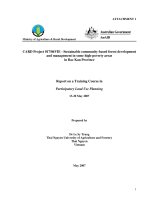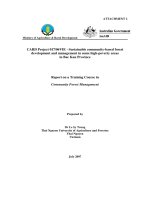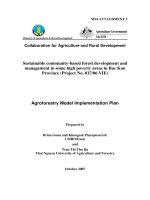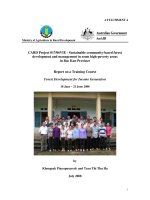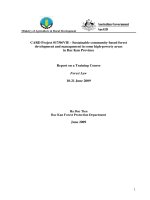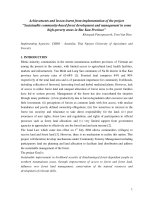Reseach on building models of community - based tourism (the case of Giang Mo Village, Cao Phong district, Hoa Binh province
Bạn đang xem bản rút gọn của tài liệu. Xem và tải ngay bản đầy đủ của tài liệu tại đây (283.07 KB, 31 trang )
1
VIETNAM NATIONAL UNIVERSITY, HANOI
INSTITUTE OF VIETNAMESE STUDIES AND DEVELOPMENT SCIENCES
DANG HOANG GIANG
RESEARCH ON BUILDING MODELS OF
COMMUNITY- BASED TOURISM
(CASE STUDY OF GIANG MO VILLAGE, CAO PHONG
DISTRICT, HOA BINH PROVINCE)
MASTER THESIS SUMMARY
Speciality: Vietnamese Studies
Code: 60.31.60
Hanoi, 2011
2
The thesis was completed in Hanoi
Supervisor: Dr. Le Anh Tuan
Reader 1:……………………………………………………………
Reader 2:……………………………………………………………
The thesis will be defended in the meeting of Thesis Council at the
Institute of Vietnamese studies at …… o’clock on the date of…:
Month…………….: Year…………………
The thesis can be found at:
Library and Information Center, Vietnam national University, Hanoi
3
CONTENTS
INTRODUCTION Error! Bookmark not defined.
1. Reason for theme Error! Bookmark not defined.
2. Aims and objectives Error! Bookmark not defined.
3. History of the research problem Error! Bookmark not defined.
4. Subject and scope of the research Error! Bookmark not defined.
5. Research Methodology Error! Bookmark not defined.
6. The layout of the thesis Error! Bookmark not defined.
Chapter 1: THEORITIACL AND PRACTICAL FRAMEWORK OF
COMMUNITY - BASED TOURISM Error! Bookmark not defined.
1.1. History and opinions of the formation of community - based tourism Error!
Bookmark not defined.
1.1.1. History of the formation of community - based tourismError! Bookmark not
defined.
1.1.2. Opinions of community - based tourism Error! Bookmark not defined.
1.2. Conditions and principles of community tourism development Error!
Bookmark not defined.
1.2.1. Conditions of community - based tourism developmentError! Bookmark not
defined.
1.2.1.1. Tourism resources Error! Bookmark not defined.
1.2.1.2. Material and technical facilities Error! Bookmark not defined.
1.2.1.3. Transportation Error! Bookmark not defined.
1.2.1.4. Support service for tourism Error! Bookmark not defined.
1.2.1.5. The preparation of community Error! Bookmark not defined.
1.2.2. Principles of community - based tourism developmentError! Bookmark not
defined.
1.2.2.3. Tourism activities decided by local communityError! Bookmark not defined.
1.2.2.4. Preserving resources Error! Bookmark not defined.
1.3. Role of community - based tourism developmentError! Bookmark not
defined.
1.3.1. The role of community - based tourism for local communityError! Bookmark
not defined.
1.3.2. The role of community - based tourism for local economyError! Bookmark
not defined.
4
1.3.3. The role of community - based tourism for resource conservation Error!
Bookmark not defined.
1.4. Some of experiences in developing community - based tourism modelError!
Bookmark not defined.
1.4.1. In the world Error! Bookmark not defined.
1.4.2. In Viet Nam Error! Bookmark not defined.
1.4.2.1. Models of community - based tourism in Sin Chai village, Sa Pa district, Lao
Cai province Error! Bookmark not defined.
1.4.2.2. Models of community - based tourism in Doi village, Namdong district, Thua
Thien Hue province Error! Bookmark not defined.
1.5. Conclusion of chapter 1 Error! Bookmark not defined.
Chapter 2: CURENT SITUATION OF THE COMMUNITY-BASED
TOURISM OPERATE AND DEVELOPMENT IN HOA BINH PROVINCE
Error! Bookmark not defined.
2.1. Tourism potentiality of Hoa Binh provinceError! Bookmark not defined.
2.1.1. Natural tourism resources Error! Bookmark not defined.
2.1.2. Human tourism resources Error! Bookmark not defined.
2.2. Models of community - based tourism in Lac village, Maichau districtError!
Bookmark not defined.
2.2.1. The formation and development of community - based tourism in Mai
Chau Error! Bookmark not defined.
2.2.2. Characteristics of community - based tourism model in the Lac, Mai Chau
district Error! Bookmark not defined.
2.2.2.1. The role of community Error! Bookmark not defined.
2.2.2.2. Types of products Error! Bookmark not defined.
2.2.2.3. Characteristics of tourists Error! Bookmark not defined.
2.2.2.4. Cooperation mechanisms and sharing related benefitError! Bookmark not
defined.
2.2.3. The advantages of community - based tourism to economy, society and
culture Error! Bookmark not defined.
2.2.3.1. Positive impacts Error! Bookmark not defined.
2.2.3.2. Negative impacts Error! Bookmark not defined.
2.2.4. Evaluation of community-based tourism model in the Lac village, Mai
Chau district Error! Bookmark not defined.
2.2.4.1. Strengths Error! Bookmark not defined.
2.2.4.2. Limitations and causes Error! Bookmark not defined.
5
2.2.4.3. The lessons experience Error! Bookmark not defined.
2.3. Characteristics of community – based tourism in Cao Phong district, Hoa Binh
province Error! Bookmark not defined.
2.3.1. Overview of Cao Phong district Error! Bookmark not defined.
2.3.1.1. Geographic features Error! Bookmark not defined.
2.3.1.2. Administrative boundaries Error! Bookmark not defined.
2.3.1.3. Economic development of Cao Phong districtError! Bookmark not defined.
2.3.2. Tourism potentiality of Cao Phong Error! Bookmark not defined.
2.3.2.1. The basic values Error! Bookmark not defined.
2.3.2.2. Conditions of infrastructure and technical facilitiesError! Bookmark not
defined.
2.3.3. Reality of tourism development in the Giang Mo village, Cao Phong
district Error! Bookmark not defined.
2.3.3.1. Overvew of the Giang Mo village Error! Bookmark not defined.
2.3.3.2. The result of tourism activities Error! Bookmark not defined.
2.3.3.3. Local communities with tourism activitiesError! Bookmark not defined.
2.3.3.4. Other characteristics Error! Bookmark not defined.
2.3.4. Evaluation of the activities of tourism development in the Giang Mo, Cao
Phong district Error! Bookmark not defined.
2.3.4.1. Strengths Error! Bookmark not defined.
2.3.4.2. Limitations and causes Error! Bookmark not defined.
2.4. Compare models of tourism development in Ban Lac, Mai Chau district
with Giang Mo village, Cao Phong district . Error! Bookmark not defined.
2.4.1. The same Error! Bookmark not defined.
2.4.2. The different Error! Bookmark not defined.
2.5. Conclusion chapter 2 Error! Bookmark not defined.
Chapter 3: DETERMINATION OF BUIDING MODELS OF COMMUNITY -
BASED TOURISM IN CAO PHONG DISTRICT, HOA BINH PROVINCE
Error! Bookmark not defined.
3.1. Determine of tourism development of Hoa Binh ProvinceError! Bookmark
not defined.
3.1.1. Aim of tourism development Error! Bookmark not defined.
3.1.2. Tasks Error! Bookmark not defined.
3.2. Orientation for tourism development of Cao Phong district Error!
Bookmark not defined.
6
3.3. Determine building community - based tourism model in the Giang Mo
village, Cao Phong district Error! Bookmark not defined.
3.4. Put forward community - based tourism development model in Giang Mo
village, Cao Phong district Error! Bookmark not defined.
3.4.1. Basis of the proposals Error! Bookmark not defined.
3.4.2. Principles to develope community - based tourism model in Giang Mo
village, Cao Phong district Error! Bookmark not defined.
3.4.3. Content of model Error! Bookmark not defined.
3.4.3.1. Defining the role of community Error! Bookmark not defined.
3.4.3.2. Determine the role of management Error! Bookmark not defined.
3.4.3.3. Determine the role of tourism companiesError! Bookmark not defined.
3.4.3.4. Building community mechanism in the benefit sharing between subjectsError!
Bookmark not defined.
3.4.3.5. Identify types of products and services Error! Bookmark not defined.
3.4.4. The conditions to establish the model Error! Bookmark not defined.
3.4.4.1. The policy of authorities Error! Bookmark not defined.
3.4.4.2. The availability of community Error! Bookmark not defined.
3.4.4.3. Knowledge of people Error! Bookmark not defined.
3.4.4.4. Infrastructure, facilities upgraded and other essential conditionsError! Bookmark not
defined.
3.5. Applying the model for Cao Phong Error! Bookmark not defined.
3.6. Some recommendations Error! Bookmark not defined.
3.6.1. Recommendations to the State management agency on tourism Error!
Bookmark not defined.
3.6.2. Recommendations to the provincial People's Committee of Hoa Binh and
People's Committee of Cao Phong district Error! Bookmark not defined.
3.6.3. Recommendations for the People's Committee of Binh Thanh communeError!
Bookmark not defined.
3.6.4. Recommended for local people Error! Bookmark not defined.
REFERENCES Error! Bookmark not defined.
7
INTRODUCTION
1. Reason for theme
Nowadays, tourism has become a necessity of life. It is not only a key
economy of nations but also a bridge of cultural exchanges among nations and
areas in the world.
Recently, the tendency of visiting remote mountainous regions, where
ethnic minorities live, becomes very popular, especially as for foreign tourists
and the youth because of wild natural landscapes and original cultural traits.
8
Consequently, another from of tourism has been development, known as
community - based tourism.
Community - based tourism is one of very attractive tourism types. It has
brought in many benefits of economy and society to communities in the world.
In Vietnam, this type has been researched and put into practice in many locals.
Cao Phong district, Hoa Binh province, has many tourism resources.
Among them community - based tourism relies on exploring culture of ethnic
minorities in Giang Mo - the most typical village. However, the tourism
operation there has not been managed effectively to meet its potentials. Thus, in
the current tourism tendency, studying and expanding the community - based
tourism in Giang Mo are very important.
In order to improve tourism operations in Cao Phong, it’s necessary to
study tourism potentiality as well as reality of the district. From that, we can
design and build the suitable model. For these reasons, the researcher decided to
carry out an investigation into the issue titled: “Research on building models of
community - based tourism in Cao Phong district, Hoa Binh province (for
example the Giang Mo)”.
2. Aims and objectives
Aims: orientate to building community - based tourism model in Cao
Phong district, Hoa Binh
Objectives:
- To systematize theoretical issues about community - based tourism
- To analyze experience in developing community tourism in Mai Chau
and some other locals in Vietnam
- To analyze evaluate developing community tourism in Cao Phong
- To compare model community - based tourism of Lac village to
bring out community based model in Cao Phong
3. History of the research problem
9
There were a great number of scientific studies on community - based
tourism such as:
“Community - based tourism for Conservation and Development”
published in 2003 by The Mountain Institute (America), “Community - based
tourism – theory and use” (volume 1), PhD. Vo Que (2006), "Sustainable
tourism" by Nguyen Dinh Hoe and Vu Van Hieu (2001), "Tourism with
problems of ethnic minorities in Sa Pa" by Pham Thi Mong Hoa and Lam Thi
Mai Lan (2000),…etc
4. Subject and scope of the research
- Subject of research: community - based tourism form and development
conditions of community - based tourism.
- Scope of content: community relies on exploiting ethnic minorities’ culture.
- Scope of space: Cao Phong district, with the Giang Mo village is
focused to research Mai Chau district, with Lac village is comparison subjects.
- Scope of time: information and data collected from 2005 to 2010.
5. Research Methodology
Researcher used 6 methods of scientific research: Researching synthesis
theory, comparative approach, methods of sociological investigation,
observation, questionnaire method, methods of analysis and synthesis.
6. The layout of the thesis
Besides the introduction, conclusion, addendums, references, the thesis
includes three chapters as followings:
Chapter 1: Theoretical basis and reality of community - based tourism
Chapter 2: Current situation of the community-based tourism
development operations in Hoa Binh prefecture
10
Chapter 3: Orientation of building models of community - based
tourism in Cao Phong district, Hoa Binh province
Chapter 1: THEORITIACL AND PRACTICAL FRAMEWORK OF
COMMUNITY - BASED TOURISM
Chapter 1 presents theoretical basics, concepts of community - based
tourism, principles and conditions of community - based tourism. Concurrently,
chapter 1 also provides some experience about community - based tourism in
Vietnam and other countries.
1.1. History and opinions of the formation of community - based tourism
1.1.1. History of the formation of community - based tourism
Community - based tourism (CBT) was derived from tourism village
operations in 1970s. Visitors went on walking around village, discovered
customs and culture, daily life, festivals of local residents or certain travelers to
participate in ecotourism activities. At that time, tourists needed the support of
local people as guidance, food, accommodate They called it "the trip has the
support of local people." That is the premise for the concept of community
tourism development and community - based tourism.
Community - based tourism began to develop in Africa, Australia, and
America in 1980s and 1990s with the help of NGOs and IUCN. Community - based
tourism began to develop straightly in Asia concluding ASEAN countries.
1.1.2. Opinions of community - based tourism
The researcher introduces different concepts of scientists around the
world and conceptualizes community tourism in the scope of the thesis
Community-based tourism develops sustainable regional community in
which the subject is directly involved in tourism activities. Regional community
providing travel services while conserving the culture resources, natural
resources and environment. Concurrently, regional community benefit
11
materially and spiritually from tourism and conservation achievements that”.
1.2. Conditions and principles of community tourism development
1.2.1. Conditions of community - based tourism development
To develop community - based tourism, it is necessary to ensure these
conditions: tourism resources, material facilities, and support services for
tourism, transport, participation of community and policy of local authorities,
which influence the formation and development of community tourism. Among
them, the tourism resources and participation of local community are
extraordinarily important.
1.2.2. Principles of community - based tourism development
Some principles in order to develop community - based tourism are:
- Relying on local community
- Allocating profit reasonably
- Tourism activities decided by local community
- Preserving resources
1.3. Role of community - based tourism development
The role of community - based tourism development is analyzed in terms
of: local community, local economy and resource conservation.
1.4. Some of experiences in developing community - based tourism model
1.4.1. In the world
Community - based tourism has been recommended in Huai Hee village,
Mae Hong Son province of Thailand.
Huai Hee village is located in Mae Hong Son national park. It is a small,
ethnic Karen community, covering 26 km southeast of Mae Hong Son city. The
village lies at the base of Doi Pui, the provinces’ highest mountain. Local residents
of are ethnic minorities. Mostly Karen people is mainstream economy of Karen
people is the exploitation of forest resources. People's lives are very difficult.
12
After a period of research, local community, non-government
organizations, and authorities of Thailand have brought out community - based
tourism model in Huai Hee. Due to, the local people’s live is better and
preserving forest resources of Mae Hong Son national park is more effective.
1.4.2. In Vietnam
In the late 1990s of the 20 century, community - based tourism forms
began to develop strongly in Vietnam. Community - based tourism in Vietnam
is held in various forms such as: visiting ancient villages, going to mountain
forests, going to country sides, discovering ethnic minorities’ culture…Among
them discovering ethnic minorities’ culture is the most attractive.
Models of community - based tourism in Sin Chai village, Sa Pa district,
Lao Cai province
Sin Chai village lies at mountain side of Hoang Lien Son line, 4 km from
Sa Pa town. The population is mainly ethnic H’Mong living about 120
households migrating from China since the 17th century. H’Mong in the Sin
Chai still preserves many their traditional cultural identities. The natural
conditions and economic – cultural – social conditions are attractive. Therefore,
in recent years, there are great number of visitor go to visit. However, besides
the benefits that tourism brings, the negative impacts on the life of local
residents are very great.
In 2001, the International Union for Conservation of Nature (IUCN)
together with The Netherlands Development Organization (SNV) planned a
community - based tourism development program in the Sin Chai within the
framework “Reinforcing competence for sustainable tourism imitative”.
Criterion of model is aspiring to take part in tourism services in order to
develop sustainable community, preserve community culture and natural
resources.
13
Models of community - based tourism in Doi village, Namdong district,
Thua Thien Hue province
Doi Village is located in Thuong Lo commune, Namdong district, Thua
Thien Hue province, 60km from Hue city in the valley near Bach Ma National
Park. The residents are mostly Co Tu ethnic estimated with approximately
37.000 people. The life is very difficulty because of the economic self –
sufficiency. In July, 2003, SNV organization that cooperated with Service of
Culture, Sports and Tourism of Thua Thien Hue province build based
community tourism development project. Aim of the project was to eliminate
hunger, reduce poverty, and develop of natural tourism and human tourism
resources in Doi village. Criteria of model ware to develop the potential of
community-based tourism to reduce poverty, promote sustainable livelihoods
and other rural development objectives.
1.5. Conclusion of chapter 1
Chapter 2: SITUATION OF THE COMMUNITY-BASED TOURISM
OPERATE AND DEVELOPMENT
IN HOA BINH PROVINCE
Chapter 2 presents the conditions for tourism development in Hoa Binh.
The chapter also introduces community - based tourism model in Lac village,
Mai Chau district. The conditions and reality of development tourism operation
in Giang Mo village include: the conditions about natural resources, local
residents, infrastructure and technical material, the policies and support. The
researcher assesses advantages and disadvantages of community - based
tourism model in Lac village. Thenceforth, learning from the experiment in
order to orient community - based tourism in Giang Mo village.
14
2.1. Tourism potentiality of Hoa Binh province
Hoa Binh is a mountainous province lying in the northwestern region of
Vietnam. It borders Phu Tho and Son La province at the northern and north-
western relatively, Ha Tay (old) and Ha Nam province at the eastern and
southeastern, Ninh Binh and Thanh Hoa province at the southern and
southwestern.
Hoa Binh is one of the northern mountainous provinces with many ethnic
minorities making up a culture of diversity. This is a great strength of tourism there.
2.1.1. Natural tourism resources
Hoa Binh is rich in natural tourism resources including some of the
highlights as follows: Hoa Binh Lake, Kim Boi mineral water springs, stalactite
cave system, the system of primeval forest
2.1.2. Human tourism resources
By the end of October 2005 the province of Hoa Binh had 158
monuments of all kinds included in the vestiges list. It consisted of 80
monuments of archaeological monuments, 14 historical sites and 34 cultural
vestiges spots. Among them, 31 vestiges were recognized and ranked by the
Ministry of Culture, Sports and Tourism, 6 vestiges were ranked special
monument to the provinces. Specifically:
Typical festivals: Opening Lower Muong Bi Festival (Tan Lac district), Bo
temple festival (Cao Phong district), Tien pagoda festival (Lac Thuy district)
Object of ethnology: Giang Mo (Cao Phong district), the Lung Van (Tan
Lac district) of the Muong ethnic and the Thai village in Mai Chau district like
the Pom Coong village, the Van village
Works of modern inventions: such as Hoa Binh hydroelectric plant, the
Hoa Binh Museum, Ho Chi Minh statue in the locality of Hoa Binh City which
are very convenient for tourists to visit.
15
2.2. Models of community - based tourism in Lac village, Mai Chau district
2.2.1. The formation and development of community - based tourism in Mai Chau
Mai Chau is a mountainous district lying the western province of Hoa
Binh, about 140 km away from Ha Noi. Lac village is located in the Chieng
Chau commune, Mai Chau district. People living here are mostly White Thai
ethnic with special cultural tradition. Community - based tourism in the Lac
village was established in 1960.
Currently, Lac village has 110 households, among them 27 households
registered tourism business. There are also many other households who run
business but do not register with local authorities
2.2.2. Characteristics of community - based tourism model in the Lac, Mai
Chau district
2.2.2.1. The role of community
Local people are directly involved in the organization of tourism activities
and service provision for customers. They are not only the custodians of
traditional cultural values of the ethnic but also people involved in the
organization of tourism activities.
2.2.2.2. Types of products
- Welcoming guests staying at home (homestay): 27 among 100
households register accommodation service. Each house can accommodate
from 30 to 50 tourists
- Serving eats and drinks: the hosts directly cater tourists. Depending on
tourist’ demand, they offer different menus.
- Performing arts: Lac village has 4 performance teams. Each show costs
500,000 VND along with 1 Ruou Can bottle.
- Guiding visitors to go sightseeing on foot in the Mai Chau area: local
guides have led the way and introduced Thai ethnic culture to visitors.
16
- Demonstrating production of handicraft items: the hosts organize for the
guests to visit the manufacturing operations as customers demand.
2.2.2.3. Characteristics of tourists
In the late 1980s, visitors to Mai Chau were mostly embassies and experts
from countries of Eastern Europe and Western Europe for work. In the early
1990s, Mai Chau became eco-cultural tourism and welcomed visitors back to
sleep, attracting many domestic and foreign tourists, mainly Western Europe
and Eastern Europe such as France, Britain and the Netherlands. The French
visitors were the most crowed. After Vietnam normalized relations with the
U.S. in 1995, America, Canada tourists began to come to Vietnam.
2.2.2.4. Cooperation mechanisms and sharing related benefit
The organizational structure of community - based tourism activities in
Mai Chau has the participation of three main components: local communities,
local authorities and tour operators, in which local communities are the subject.
Each year, households subscribing business have to pay 10% of total income for
local governments and enjoy the rest. The local authorities are responsible for
security, ticket revenue landscape, tax revenue of the household. Other related
travel companies have to purchase spots tickets of 7000 VND per one.
2.2.3. The advantages of community - based tourism to economy, society and culture
So far, tourist activities in Mai Chau have taken place almost half a
century. Tourism activities have brought both positive effects and caused
negative effects to local communities.
2.2.3.1. Positive impacts
The researcher presents the positive impacts of tourism in terms of:
- Economy
- Culture - society
17
- Environment
2.2.3.2. Negative impact
Tourism has resulted in negative effects on:
- The traditional cultural values of local communities
- The lifestyle of local communities
- Environmental Landscape
2.2.4. Evaluation of community-based tourism model in the Lac, Mai
Chau district
2.2.4.1. Strengths
The reality of tourism activities in the Lac community can take out some
strength as follows:
- Mai Chau has become a bright spot in the tourism map of Vietnam.
International tourists and domestic ones to Mai Chau are more and more.
Number of visitors reaching 42,500 in 2009 has increased 3.3 times compared
with 2000; revenue from tourism in 2009 was 19,500 million increasing 23
times compared with sales in 2000.
- The mechanism of sharing benefit between component parts: the local
people benefit directly from the service provider. The local government also
benefit from the landscapes of tickets.
- Development of tourism activities has contributed to preserving some
traditional cultural values of local communities, arousing the people's pride
about the cultural identities, improving their cultural knowledge of the
integration of village communities in the world. Through tourism activities, the
link between households is more close-knit.
- The landscape and habitat for people improve. Infrastructure
construction is also exploited and invested more.
18
- Tourism activities have contributed to changes in economic structure,
increasing income to help improve people's lives.
2.2.4.2. Limitations and causes
- Tourism sources are entirely dependent on travel agency’s arrangement
and layout. People have no right to be in charge of tourism service.
- All of tourism services lack the attention of the authorities. Families
organize by themselves and contact with tour operators to welcome visitors.
- Local people are not helped with finance assistance and experience of
organizations at home and abroad.
- The division of finance revenues from tourism activities: the
government’s revenue from landscapes ticket sales and revenues of 10% of the
people. However, local people do not know what the government use that
money for.
- The conservation, protection of natural resources and cultural ethnic has
not been adequate attention to. Many traditional cultural values have been
eroded or transformed. Tourism has disrupted traditional living spaces of local
people. The lifestyles of local people tend to follow market changes.
- Development of tourism activities in the Lac has the participation of the
community - local government – business travel but the level of participation of
parties is different.
- Tourism activities in Mai Chau community do not receive any support
of organizations in developing services, travel or tourism development program.
2.2.4.3. The lessons experience
- There must be unity, equitable distribution of benefits between the
parties, members of the community.
19
- To pay attention to full exploitation of the strengths of the local to
create, attractive and unique tourism products this will inspire visitors to find
out to satisfy their demand.
- In relation with visitors, local people need a friendly attitude, willingness to
welcome guests and introduce customs to guests.
- Training and fostering professional travel needs special attention.
- Sustainable community development must be planed to conserve
tourism resources and environmental sanitation of the locality.
2.3. Characteristics of community - based tourism in Cao Phong, Hoa Binh
2.3.1. Overview of Cao Phong district
2.3.1.1. Geographic features
Cao Phong is one of the highland districts of Hoa Binh province boring
the eastern borders of Kim Boi district, Tan Lac district, the northern borders of
Da Bac District and Hoa Binh town, the south borders Lac Son district.
Cao Phong district’s territory can be divided into three regions: the
mountains (Yen Thuong and Yen Lap communes), the middle (including 8
communes: Dung Phong, Nam Phong, Dong Phong, Tay Phong, Tan Phong,
Bac Phong, Thu Phong, and the town of Cao Phong) and the Da river area
(Binh Thanh and Thung Nai communes).
Cao Phong climate is tropical, hot and humid, hot and rainy in summer, cold
and dry in winter. The average temperature is from 22 to 24 degrees Celsius.
20
2.3.1.2. Administrative boundaries
In 2001, Cao Phong district was established with 13 communes and 1
town: Nam Phong, Tan Phong, Dong Phong, Xuan Phong, Thu Phong, Bac
Phong, Binh Thanh, Thung Nai, and the town of Cao Phong.
2.3.1.3. Economic development of Cao Phong district
Before the August Revolution in 1945, Cao Phong was under the rule of
the regime Lang.
When invading Vietnam, French colonialists continued to use this object
to rule and exploit people.
Since the August Revolution succeeded, Cao Phong district has
developed economics under the leadership of the Socialist State of Vietnam
Democratic Republic.
2.3.2. Tourism potentiality of Cao Phong
2.3.2.1. The basic values
Cao Phong has many tourism resources including natural and human
resources. Especially, the elements of tourism human resources are very
attractive to tourist such as:
Cao Phong – Thach Yen historical – cultural monument of national level:
It is located in Yen Thuong commune and far approximately 13km from
highway 6. This revolutionary base, established in early 1945 is one of four
areas of the provincial revolutionary bases in the war zone system Hoa - Ninh -
Thanh. It was built and directed the by the Tonkin regional party committee.
Khanh pagoda is located in this area. Khanh pagoda is valuable in terms
of spirituality. Khanh Pagoda is located on the hill; the three-level design
consists of five main rooms. The characteristics of Khanh pagoda are not
Buddha statues or human spirit but are stone gods.
21
Da river landscape in Thung Nai Commune: it is far from the center of
Hoa Binh city about 25km. This travel spot is considered a "Ha Long Bay
miniature".
Thac Bo temple: this is the religious and cultural center of people
belonging to Thung Nai commune. The main festival of the Thac Bo temple is
on 7
th
, January according to lunar calendar.
Cao Phong cave system: caves are located in the range of mountains stone
of Cao Phong town, far from highway 6 about 1 km.
2.3.2.1. Conditions of infrastructure and technical facilities
- Traffic system by sea and on ground is convenient, especially the road
system, in which highway 6 crosses districts Cao Phong, through the town of
Cao Phong. Highway 6 is the life-line road linking Hanoi and Hoa Binh with
mountainous northwestern areas. The road 21A begins at junction 6 near Cun
slope running to the eastern and connects Cao Phong with Kim Boi and Ha Tay
province (old), Ha Nam.
- Accommodation system: the district currently has 4 houses with 24
rooms and 8 houses on stilts.
- Electrical systems and communications: so far 100% communes and
townships of Cao Phong have been provided the national power grid and almost
all villages have mobile wave of Viettel, Vinaphone.
2.3.3. Reality of tourism development in the Giang Mo village, Cao
Phong district
2.3.3.1. Overvew of the Giang Mo village
Giang Mo is located next to highway 6 (old), to the west of city and far from
the center city about 9 km, far from the highway 6 (new) about 7km. Giang Mo is a
tourism point based on exploiting the value of the Muong ethnic culture.
22
Giang Mo preserves many both physical and mental unique cultural
values of the Muong: housing, clothing, the manners and customs However
the people's life is still difficult. Household’s average income is from 500.000
VND per month to 1.000.000 VND per month.
2.3.3.2. The result of tourism activities
Regarding to the number of visitors:
Cao Phong has welcomed 93.694 visitors and the revenue reached 4635
million in 2009. Obviously, the number visitor is large but the revenue is small.
The number of visitors to Giang Mo is not estimated in detail. Giang Mo
welcomed the very first visitors approximately from 1980 to 1990. At that time,
the main customers to Giang Mo were Soviet Union when they built Hoa Binh
hydroelectric plant. Since 1996, the number of foreign visitors has increased,
mostly are French visitors. Giang Mo was the most crowded between 2000 and
2003, estimated 7000 - 9000 visitors per year. They came from many nations
such as: Korea, French, Japanese, Germany, and Denmark…The most crowded
is Korea visitors. From 2004 up to now, the volume of visitors to Giang Mo has
showed the trend to decrease. According to statistics by residents, an annual average
visitor is about 3,000 to 4,000 visitors.
Regarding the accommodation systems: Giang Mo has more than 100
houses among them about 12 to 15 houses are likely to stay. When visitors stay,
they have to pay 40.000 VND per person per day for domestic tourists and
50.000VND per person per day for foreign visitors. The meal price depends on
visitor’s requirements.
Regarding the tourism products: tourism products at Giang Mo are
monotonous. Major activities when going to Giang Mo are walking in the
23
village and discovering the culture of the local community, buying souvenirs
and local specialties.
2.3.3.2. Local communities with tourism activities
Currently, Giang Mo has 94% of people participating in tourism
activities, but certain key activities are:
- Providing accommodation
- Introducing to visitors about the traditional culture of local community
- Performing arts
- Selling of souvenirs and local specialties.
2.3.3.3. Other characteristics
Tourism activities in Giang Mo without the help of non-governmental
organizations only include: Local community and Governmental institutions. In
particular, local communities organize work by themselves, local governments
only partially help.
2.3.4. Evaluation of the activities of tourism development in the Giang Mo,
Cao Phong district
2.3.4.1. Strengths
- The natural landscape: Giang Mo natural landscape is very beautiful and
impressive. The life is in harmony with wild nature. The weather is fresh and
cool. The average temperature is from 23 to 27 degree Celsius.
- The natural tourism resources and the human tourism resources:
preserving many material and spiritual traditional cultures of the Muong ethnic.
24
Besides, Giang Mo has many historical monuments such as: Cu Chinh Lan hero
statue, Thac Bo temple, the Muong Cultural Space museum.
- The geographical conditions: The geography of Giang Mo is quite
advantagous far from the highway 6 about 7km and the road leading to the
village is very convenient. Giang Mo village is located closely to the central
tourism area of Hoa Binh Lake, so it can be easy to associate tours. Especially,
the Lake area of Thung Nai village is just far from Giang Mo 8 km. Thung Nai
village is known as "Ha Long Bay miniature" which is very attractive to tourist
at weekend.
- The transportation system has been asphalted from highway 6 to the Thung
Nai port. Thung Nai port was equipped with boats taking visitors to the ceremony
of Thac Bo temple or yacht to enjoy the beauty of the Hoa Binh Lake.
- Participation of local communities: local people in Giang Mo are
extremely prepared to participate in arranging and serving tourits.
2.3.4.2. Limitations and causes
- Nature of model: not planned to develope, the tourism activities take
place spontaneously.
- Financial issues: tourism activities in Giang Mo have not received any
significant investment by government.
- The degree of understanding and experience of people about tourism: local
community is inexperienced and lack of knowledge needed for tourism in travel
business.
- Lack of support from government and non-governmental organizations.
- The tourism products: according to the visitors, there are 67.6% of
visitors commenting that the tourism activities in Giang Mo are also
monotonous and poor.
- Profit splitting mechanism: not clear among the parties
25
- The promotion of tourism: tourism promotion is still insufficient.
2.4. Compare models of tourism development in Ban Lac, Mai Chau
district with Giang Mo village, Cao Phong district
The researcher comparing the similarities and differences in models of
community - based tourism in the Giang Mo village and in the Lac village is the
basis for building a community - based tourism model for Giang Mo in chapter 3.
2.4.1. The same
2.4.2. The different
2.5. Conclusion chapter 2
CHAPTER 3
DETERMINATION OF BUIDING MODELS OF COMMUNITY -
BASED TOURISM IN CAO PHONG DISTRICT,
HOA BINH PROVINCE
Chapter 3 presents tourism development orients Hoa Binh province and
Cao Phong district, puts forward solution development, determines model and
gives some petitions in order to exploit the conditions to develop community -
based tourism in Cao Phong.
3.1. Determine of tourism development of Hoa Binh Province
3.1.1. Aim of tourism development
- To promote the advantages of tourism, sustainable tourism
development, diversifying and improving product quality and tourism service.
Priority to accelerate the implementation of investment projects in tourism
infrastructure, technical facilities and tourism.
- To intensify investment in technical infrastructure for tourism, strive to
increase for the number of rooms in tourism accommodation to 5000 rooms in

